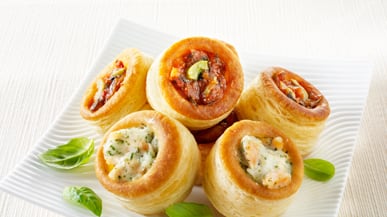There's very little private puff pastry-making anymore. I'm not even sure that many people nowadays could reliably identify puff pastry as puff pastry. Immersed as I am in the stuff, I've been slow to realize this; but after three years of "You make your own puff pastry?" or more likely, "Who makes your puff pastry?" I now see that by the standards of modern American society, I do something comparable to concocting my own laundry detergent.
Let's klatsch: Puff pastry is neither pie dough (like a knife in my heart) nor phyllo (a frankly banal suggestion). Rather, it's a certifiable wonder of physics; a buttery science experiment in which, with enough heat, 729 alternating layers of flour and butter rise up, crisp up, and stay up to produce a profound and storied comestible. Not only does no one seem to want to try this at home; but few now seem to want to try it in commercial kitchens either. I have it on good authority that very few restaurants—nor even bakeries—make their own puff anymore.

The first time I attempted puff I was an amateur. And such is its reputation that the very idea of trying to make it made me so nervous I insisted that my stalwart and husband occupy the same room. I was following a baking chapter in a Julia Child volume. Her instructions were clear and I eventually produced a passable batch of puff. By my third try, I felt suave enough to dispense with my stalwart's soothing presence.
Making puff involves combining lots of butter, some flour, some water, and a little salt, and through pinching and shaping I produce a slab of rough, shaggy dough. I roll this out into a rectangle. I fold the rectangle into thirds, like a business letter. I turn the business letter one quarter turn to the right and roll it again into a rectangle, folding this into thirds. In all, I roll out the dough six times; each time folding into thirds and giving the dough a quarter turn to the right. With each turn-and-roll, the dough becomes increasingly refined.
I like to reflect upon the fact that this is how puff is made and has been made since its invention in 1645: Through the ages, bakers of all stripes rolling and folding once, twice, six times; making their quarter-turns to the right. The dough feels like gossamer in my hands. With all that butter it's breathtakingly soft and pliable. If I weren't working at it with purpose I'd be half-inclined to take off my clothes and roll in it.
The dough feels like gossamer in my hands. With all that butter it’s breathtakingly soft and pliable.
I've purposely streamlined these remarks to suggest the fundamental simplicity of the puff process. Butter being butter, for example, you need to make puff in a cool room lest it begin to melt. There are a number of such details that must be followed. As a puff autodidact, it's taken me longer to figure them out than someone who's been formally trained. Three years on and doing it for a living, I'm still getting better and better. Puff is that kind of thing: It takes a lot of practice to do it really well. (Though I hasten to repeat that my first batch was…completely serviceable.)
This has all been a rather roundabout way of exhorting you—if you cook at all—to have a go at puff. The taste alone is head and shoulders above any other pastry. You'll be walking in the footsteps of the many deeply committed souls before you. It's a rite of passage, a scientific wonder, a culinary foundation garment and, even without years of practice, what you'll likely produce will be… completely serviceable.
Plus: Check out Hungry Beast, for more news on the latest restaurants, hot chefs, and tasty recipes.
Following an endless career in magazines—from stints at Life, People, House & Garden, Vanity Fair and a marathon at Town & Country (including along the way, a specialty in oriental rugs)—Kate Weiner finally fled the melée for pastures green and, in what can only be described as a fugue state, began to make puff pastry by hand and to sell sweet and savory puff-pastry tarts at the Millbrook (NY) Farmers' Market. Weiner's often irritating perfectionism now finds outlet in her insistence on absolute freshness and highest quality available for all she produces. All tarts are baked on the day of sale. She feels enormous affection for her customers and wonders why it took so long to find her métier.






